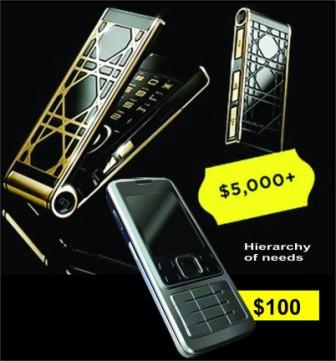The basic necessities of a person are food, shelter and clothing. However after these needs have been provided and provision has been made to ensure there is perpetual availability, the Maslow Law: Hierarchy of Needs takes over.
Basically the Abraham Maslow paper of 1943 says that once the basic needs are settled we shift our focus on making something out of our lives and enriching our existence.
As we move up the ladder of the Maslow’s pinnacle, the definition of ‘necessities’ changes.
In the minds of most people, moving up the pinnacle is mostly a factor of their financial status. Adopting this measure is extremely deceptive. The fact that you can afford an item does not make it a necessity.
The distinction between a necessity and a luxury is very blurred and our emotions play a huge role in these decisions; further blurring the distinction. We are also influenced by an avalanche of attention-grabbing commercials at every turn.
Most people differentiate between luxuries and necessities in the following ways.
- The factor of number: How many to purchase – one television in the living room is a necessity and the second television in the bedroom is a luxury.
- The factor of lifestyle: “I am supposed to get two new suits every month… and three shirts. It is a must!” Then she says: “I just hope I can afford to service my car. It is too expensive.”
- The factor of cost: Toyota Rav 4 vs Dodge Nitro 2011.
But differentiating a luxury from a necessity is not that simple because the line between them is not just blurred, it is also thin.
There are other factors that we must bear in mind when deciding whether an item is a necessity or a luxury. Some of these are:
Consequential costs: The costs that follow the initial purchase are a major factor you must bear in mind. The fact that you can afford a second car does not mean that you can afford the extra maintenance costs. The same goes for the extra channels on cable TV bouquet, or the extra cell phone.
Exposure to temptation: An item might not bring you unbearable consequential costs but it might leave you vulnerable to other temptations. For instance a bigger living room need not increase your furniture-budget, but you would not be thinking of buying a huge Leonado Davinci replica, if you did not have a bigger wall to hang it on.
Use: Considering how often you would use an item would help you decide whether or not you should buy one, hire one or forget it. An example is upgrading you mobile phone when you have no intention of using the new features.
Alternatives: Considering all the possible alternatives would help you make better decisions.
Timing: Sometimes we land in financial trouble because we just cannot wait to flaunt an item so we sacrifice a profitable investment to purchase it. This is the recipe for bankruptcy no matter how necessary we think the item is.
Keeping Up With The Joneses: It is your money. You must be strong and have a mind of your own. If your friends harass you about your prudence; change them.
Savings: If you have to touch your savings to acquire an item, then it must be an item that puts money in your pocket. For instance: buying a lovely new house with an extra flat for rent/income. If the item is not bringing you money, then leave it until you can afford it without touching that piggy bank. If you believe that you must buy it right away, then get the money elsewhere; get an extra job etc. When it comes to your savings the only necessity is an item that would bring you more money.
Debt: If you have to get into debt to buy a necessity, your first consideration should be how much the item would bring into your pocket or how much money it would save from your usual spending (e.g. transportation). The second consideration would be pay-back implications. Debt should be an advantage and not a burden.
Debt advantage –Here is an illustration: A small car (worth N500, 000 with low maintenance cost) is something you could ordinarily afford within a year if you cut down on a few frivolities. But when you take a loan, a monthly deduction from your salary puts you on a tight budget and you can no longer afford those frivolities. In other words, you used the debt to force yourself to save for the car.
On the other hand taking a loan to purchase a brand new status symbol, stretch Limousine is a burden: You would spend the next four years paying for it. Maintenance costs for such automobiles have gone through the roof: heaven forbid you have an accident. Plus, you would need a chauffeur – You cannot drive a limousine yourself, can you?
Accumulation: Whether or not you would be allowed to pay in instalments is another major factor. But the option of part-payments is not an excuse to pile up debt.
Life should be enjoyed and we should indulge in some little pleasures. Nonetheless, we have to watch our spending, but being disciplined is easier said than done.
One therapy that works is reflection. You go into your store, cellar, storage box etc. Take out all the items in there one after the other and think back to when they were new purchases and how they brought you pleasure. Then reflect on how quickly these items lost their magic.
This therapy takes the edge of the need in your mind and helps you become more objective and make a more rational decision. Remember, the treasures of today are the junks of tomorrow.





















